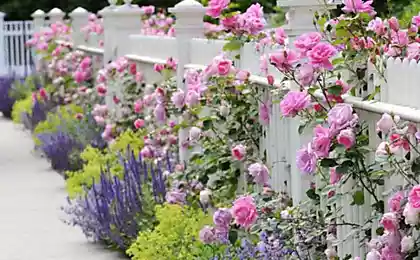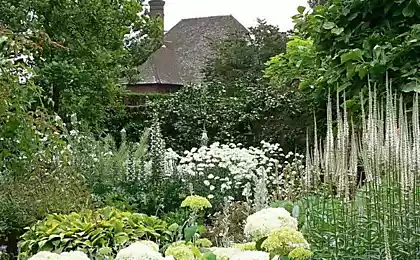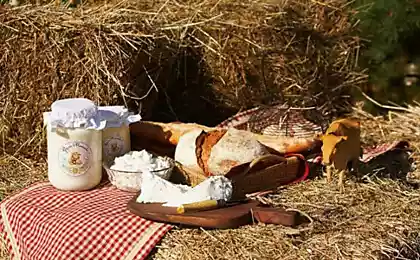239
Roses - colorful carpets in your garden
In the summer extravaganza of flowering, soil-covered roses have no equal when they frantically weave their multicolored dense carpets and spread them on the ground.
Thousands of white, pink, yellow, red, often fragrant, terry flowers adorn the sloshing or falling shoots, turning the luxury of carpet masterpieces into a fabulous vision.
Recently, the demand for ground cover roses of the new generation has increased especially, flowering of which begins in early June and continues until autumn.
At the peak of popularity among them are low spreading roses with flexible shoots covered with shiny leaves.
Especially desirable are soil cover roses in the south, southern dachas, where summer residents gave them places to decorate low retaining walls, strengthen slopes, in rockariums, on lawns, containers; they were grafted on stamps, receiving beautiful pink trees with flower cascades, from them flower curbs and hedges.
Where did it all start? The formation of soil cover roses began in the XIX century with the rose Vihura (Rosa wichuraiana), which gave shoots with a length of 6 m. It was first used as a soil cover plant. A long time ago, some gardeners-designers learned to pin the shoots of the “New Dawn” variety to the soil, turning it into a ground cover.
Since then, a lot of time has passed, and breeders-pink growers have brought real soil cover roses, distinguishing them into a separate garden group, which still continues to develop. And every year new varieties of these beautiful roses appear on the domestic and world flower markets, which in the near future will wove their carpets in many dachas.
What are soil cover roses? If you look at the soil cover roses, you will see that they differ from each other not only in color, fringe, solitary or collected in inflorescences, small or large, with aroma or without flowers, but also in how high their bushes and long shoots. Among them there are low roses, from 35 to 70 cm, but their horizontal shoots seem to crawl on the ground for 3-5 m; sometimes they even take root. Others are higher: from 90 cm and up to 1.5 m, but their shoots are not long and not creeping, but arc-shaped, drooping. The last roses are wider than the height. In the West, they are called landscape or landscape and are often used to create tall curbs.
Advantages of ground cover roses
Most varieties of winter-resistant in the southern regions, but in the middle strip of Russia and to the north they need shelter, as the shoots growing until autumn do not have time to mature and they are vulnerable to frost. Often such shoots in winter in shelter freeze, rot, are affected by fungal diseases, so in October, after the first frosts, roses are cut by 20-25 cm, unripe shoots are removed. The base of roses is steeped to a height of 10-15 cm, then, with the onset of persistent cold, shoots of soil cover roses are tied and laid on foam, lapberry, covering from above also with lapberry, ruberoid.
It's important.
Soil-covered roses are good in single and group plantings. They look beautiful on flower beds, in mixboarders, in combination with sages, nivany, digitalis and other perennials. They are luxurious on the terraces of a multi-level plot. There is a beautiful garden, which is a garden. In rockariums, low ground cover roses with small flowers are harmonious. They are incredibly beautiful on stamps.
P.S. And remember, just changing our consumption – together we change the world!
Source: www.7dach.ru
Thousands of white, pink, yellow, red, often fragrant, terry flowers adorn the sloshing or falling shoots, turning the luxury of carpet masterpieces into a fabulous vision.
Recently, the demand for ground cover roses of the new generation has increased especially, flowering of which begins in early June and continues until autumn.
At the peak of popularity among them are low spreading roses with flexible shoots covered with shiny leaves.
Especially desirable are soil cover roses in the south, southern dachas, where summer residents gave them places to decorate low retaining walls, strengthen slopes, in rockariums, on lawns, containers; they were grafted on stamps, receiving beautiful pink trees with flower cascades, from them flower curbs and hedges.
Where did it all start? The formation of soil cover roses began in the XIX century with the rose Vihura (Rosa wichuraiana), which gave shoots with a length of 6 m. It was first used as a soil cover plant. A long time ago, some gardeners-designers learned to pin the shoots of the “New Dawn” variety to the soil, turning it into a ground cover.
Since then, a lot of time has passed, and breeders-pink growers have brought real soil cover roses, distinguishing them into a separate garden group, which still continues to develop. And every year new varieties of these beautiful roses appear on the domestic and world flower markets, which in the near future will wove their carpets in many dachas.
What are soil cover roses? If you look at the soil cover roses, you will see that they differ from each other not only in color, fringe, solitary or collected in inflorescences, small or large, with aroma or without flowers, but also in how high their bushes and long shoots. Among them there are low roses, from 35 to 70 cm, but their horizontal shoots seem to crawl on the ground for 3-5 m; sometimes they even take root. Others are higher: from 90 cm and up to 1.5 m, but their shoots are not long and not creeping, but arc-shaped, drooping. The last roses are wider than the height. In the West, they are called landscape or landscape and are often used to create tall curbs.
Advantages of ground cover roses
- strong growth during vegetation and rooting of creeping shoots, giving a dense green coating, decorated with flowers of different colors during flowering;
- unpretentiousness
- resistance to diseases and pests;
- do not require annual specialized pruning;
- from 2 years of age suppress the development of weeds;
- They are easily multiplied by cuttings, castings.
Most varieties of winter-resistant in the southern regions, but in the middle strip of Russia and to the north they need shelter, as the shoots growing until autumn do not have time to mature and they are vulnerable to frost. Often such shoots in winter in shelter freeze, rot, are affected by fungal diseases, so in October, after the first frosts, roses are cut by 20-25 cm, unripe shoots are removed. The base of roses is steeped to a height of 10-15 cm, then, with the onset of persistent cold, shoots of soil cover roses are tied and laid on foam, lapberry, covering from above also with lapberry, ruberoid.
It's important.
- In order to choose the right place in the country for planting a soil cover rose, you need to know its “adult parameters”, since a denser planting will stimulate the growth of plants upwards, and a very rare one will not give a dense carpet.
- Pruning of soil cover roses is the removal in the spring of old, dead, weak and very thin shoots. The remaining shoots are shortened by 1/3.
Soil-covered roses are good in single and group plantings. They look beautiful on flower beds, in mixboarders, in combination with sages, nivany, digitalis and other perennials. They are luxurious on the terraces of a multi-level plot. There is a beautiful garden, which is a garden. In rockariums, low ground cover roses with small flowers are harmonious. They are incredibly beautiful on stamps.
P.S. And remember, just changing our consumption – together we change the world!
Source: www.7dach.ru
What is the cause of the tragedy of Anna Karenina
Watching and Punishing: John Ronson on Bullying in the Digital World






















